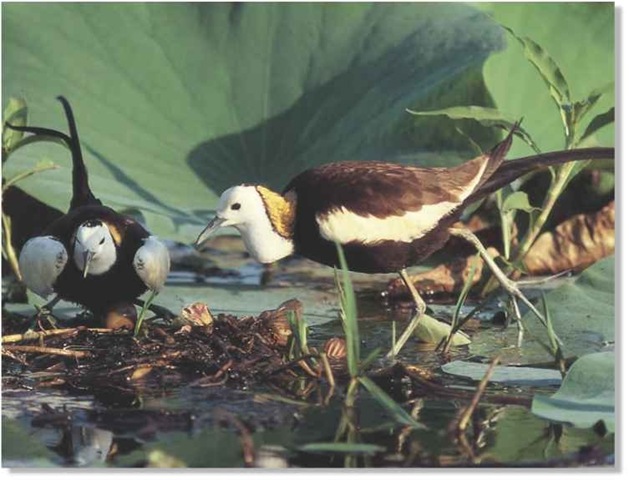ORDER
Charadriiformes
FAMILY
Jacanidae
GENUS & SPECIES
KEY FEATURES
• Female mates with several males a year, leaving each of them with a clutch of eggs to rear while she goes in search of the next breeding partner
• Male guards eggs and chicks constantly, tucking them under his wings and carrying them when he goes out foraging or flees from predators
WHERE IN THE WORLD!
Found throughout India and locally in Southeast Asia, the Philippines, Taiwan and southern Borneo; also breeds as a summer visitor in China

Lifecycle
The male pheasant-tailed jacana is a model parent. Abandoned by his mate after she lays her eggs, he accepts sole responsibility for both incubation and rearing his young brood.
HABITAT
The jacana lives among freshwater lakes, swamps and rice fields, where there’s a luxuriant growth of lilypads, lotus plants and other partially submerged vegetation. If flood or drought destroys its favored sites, the bird moves in search of another suitable habitat. In summer; the jacana mostly occurs from sea level to altitudes of 5,000′, but it has been seen at up to 12,500′ in the Himalayas. Most birds descend to warmer, low-lying wetlands in winter.
Walking on water The jacana strolls lightly over lily pads.

BREEDING
The distinctive feature of jacana society is that the female mates with several males, which are left to incubate and rear their young. A single female may mate with as many as 10 males in a season, leaving them with up to four eggs each.
Each male constructs a simple nest, weaving a raft of grass or waterweed stems. This platform may be anchored to plant stems, rest on partially submerged vegetation or float freely.
Once the chicks hatch, the male guards them constantly. He alerts them to danger with a call, at which they dive below water and remain motionless, with only their bills breaking the surface. When the father leaves the nest, he carries his young under his wings, with their long toes dangling near his belly.
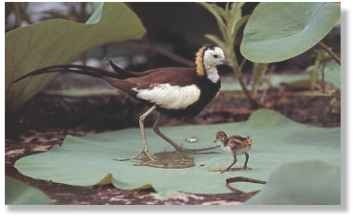
THE GREAT ESCAPE
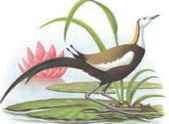
In fear…
Something disturbs the incubating male. Suspecting that his nest has been spotted by a predator, he moves his eggs to a safer place.
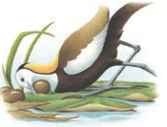
In reverse…
Tucking an egg between his bill and breast, he walks carefully backward, rolling his precious cargo over aquatic vegetation.
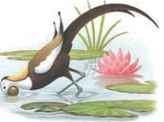
In water…
Anxious to complete the move quickly, the bird is undeterred by gaps between the lily pads, wades in and floats the egg across the water.

In safety
Having transferred the entire clutch, the male tucks the last of the eggs under his feathers and prepares to build a new nest.
• One of the local names for the pheasant-tailed jacana in India translates as “little white water princess.”
• In its spring-summer breeding plumage, the jacana resembles a magpie from a distance.
• The jacana is generally silent, but has a loud, mewing call in the breeding season.
• The name jacana is the Portuguese version of an Amazonian Indian name applied to the wattled jacana of South America.
BEHAVIOR
The pheasant-tailed jacana is stronger on the wing than other jacanas, enabling it to fly to warmer wintering areas where it often forms flocks of up to a hundred. At other times, the bird is usually seen singly or in pairs as it steps daintily, with jerking tail and high steps of its huge feet, across floating vegetation. Although its normal gait is slow and deliberate, the pheasant-tailed jacana is also capable of running at high speed when chasing off rival jacanas. It also swims well, even though it doesn’t have webbed feet.
Although wary when predators are about, the jacana isn’t normally a shy bird as far as humans are concerned and is often seen walking upon surface vegetation on village ponds only a few feet from noisy throngs of people washing and bathing.

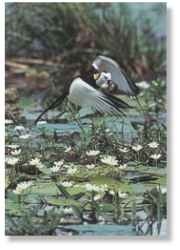
A Running scared Rarely, the male picks up an egg in his bill and flies away from a predator; he returns later to rescue any remaining eggs.
Spread the load Long toes spread its body weight so it can stand on floating vegetation.
FOOD & FEEDING
The pheasant-tailed jacana feeds on both vegetation and live prey, the proportions depending upon local availability Some experts claim that the jacana is largely vegetarian, but stomach contents have shown that mollusks form the bulk of the bird’s diet.
The jacana obtains much of its food as it treads over lush aquatic vegetation picking up mollusks, amphibian and insect larvae and seeds. It may break leisurely foraging with a sudden dash to capture an insect or small fish. It also swims in search of food and may even up-end like a duck, submerging its head and cocking its long tail feathers to reach snails and succulent roots.
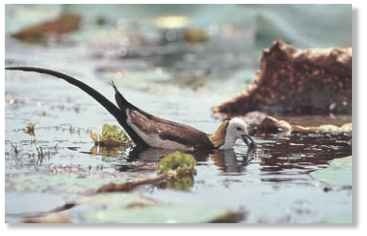
Dabble and dip A strong swimmer, the jacana pushes into open water to forage for roots.
CONSERVATION
The pheasant-tailed jacana appears to be thriving throughout its extensive range. Success is boosted both by the wide dispersal and high number of its egg clutches and its adaptable diet. It can also nest and feed in areas close to humans. Periodic climactic extremes and the drainage of wetlands may adversely affect the species’ numbers at a local level, but overall it isn’t under threat.
Profile
Pheasant-tailed Jacana
The female is very much the dominant bird in pheasant-tailed jacana society. Larger than the male, she grows an even more splendid tail.
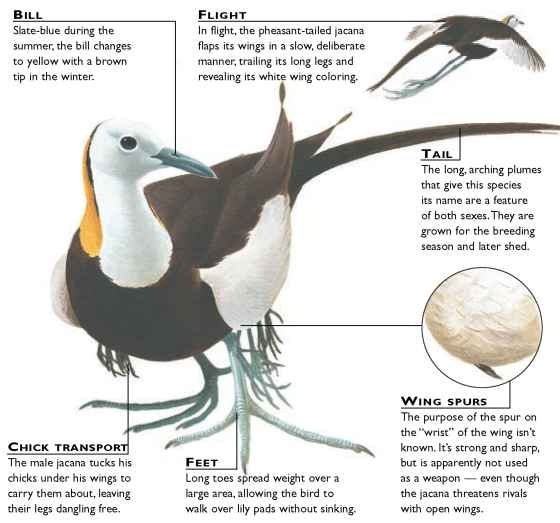
CREATURE COMPARISONS
Some of the pheasant-tailed jacana’s relatives share its distinctive habits. The African jacana, or lily-trotter; also treads lightly over floating plants, as does the American purple gallinule.
The painted snipe of Africa, Asia and Australia (more closely related to jacanas than to true snipes) shares the female jacana’s habit of takinc several mates.
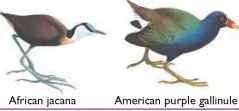
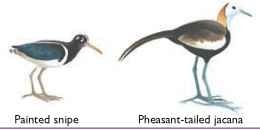
| VITAL Weight |
STATISTICS 4-6.5 oz. |
| Length | 23″ including tail plumage |
| Wingspan | 25-27″ |
| Sexual Maturity | 2 years |
| Mating season | Coincides with local rains |
| Number of Eggs | Usually 4 per clutch |
| Incubation Period | About 26 days |
| Fledging Period | 50-60 days |
| Number of Broods | 1-3 per male; up to 10 per female |
| Typical Diet | Mollusks, insects, seeds, roots |
| Lifespan | Not known |
RELATED SPECIES
The eight jacana species are found in the Americas, from southern U.S. to northern Argentina, and in Africa, Australia, India, Indonesia, Southeast Asia, New Guinea and the Philippines. Relatives include plovers, family Charadriidae, the painted snipe, Rostratulidae family, and oystercatchers, family Haematopodidae. The sandpipers, family Scolopacidae, are more distant relatives. distant relatives.
